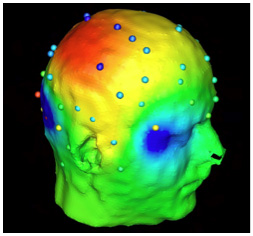SPECIAL FEATURE
Computing Research that Changed the World: Reflections and Perspectives
March 25, 2009 | 8:45 am - 5:00 pm | Members' Room, Thomas Jefferson Building, Library of Congress
Computing and Visualizing the Future of Biomedicine
CHRIS JOHNSON - University of Utah
![]() Slides - 3.3 MB
Slides - 3.3 MB
![]() Download - 261 MB
Download - 261 MB
![]() Watch the Talk (16:03)
Watch the Talk (16:03)
 Computing and visualization have led to great advances in the understanding of biomedicine, from atomic-scale particles in genes to system-scale models of vital organs. Computing and visualization remain central to biomedical understanding at all these levels. For instance, epilepsy affects over 2.5 million Americans with an estimated total health care cost of $12.5 billion. EEGs and MRI scans help to diagnose epilepsy, but are sometimes not able to adequately localize the source of an epileptic seizure. Patient specific computational models can be created to help better understand the location of the epileptic seizure. Advanced image analysis and visualization techniques can aid neurologists make better diagnoses and aid neurosurgeons with pre-operative planning.
Computing and visualization have led to great advances in the understanding of biomedicine, from atomic-scale particles in genes to system-scale models of vital organs. Computing and visualization remain central to biomedical understanding at all these levels. For instance, epilepsy affects over 2.5 million Americans with an estimated total health care cost of $12.5 billion. EEGs and MRI scans help to diagnose epilepsy, but are sometimes not able to adequately localize the source of an epileptic seizure. Patient specific computational models can be created to help better understand the location of the epileptic seizure. Advanced image analysis and visualization techniques can aid neurologists make better diagnoses and aid neurosurgeons with pre-operative planning.
Creating patient specific computer models starts by using image analysis algorithms to segment the different tissues (scalp, skull, white matter, gray matter, etc). These segmented images are then used to create geometric computer models using algorithms from computational geometry. Not long ago, such complex computations could take several hours. Now because of parallel processing with Graphics Processing Units (GPUs), computation times can be reduced significantly, sometimes by orders of magnitude. The reduction in computing time is significant because it can enable the creation of patient-specific computing simulation and visualization and help realize personalized medicine in the future.
High resolution tools have allowed us to see science in new ways. Most great discoveries are preceded by the creation of a new tool. High-performance computing and visualization are such tools (GPUs, algorithms, software, etc.). It is critical to continue developing such tools to enable new discoveries that lead to better diagnosis, treatment, and medical care.
What does it take to create new forms of visualization for biomedicine? Computer scientists and biologists must work together closely. Having a team of experts is important. Each expert needs to know just enough about the other disciplines. The greatest stumbling block is often a lack of communication between disciplines, often because different disciplines use different technical languages.
In the early stages of Chris JohnsonÕs research, the biomedical simulations and visualizations were quite simplified when compared to "real" biomedical complexity and were not very impressive to the eye. It was difficult to attract mindshare from the biomedical community. A brain might have looked like an unremarkable sphere. Now with the advancement and success of computer algorithms, software, and hardware, biomedical scientists often seek to collaborate with computer scientists working in image analysis, digital geometry, simulation, and visualization.
What is the role of cooperation between the public and private sector and models that lead to success? The Johnson research group fosters entrepreneurship that has led to the spin-off of four startup companies. Dr. Johnson also works with several companies ranging from biomedical companies to oil and gas companies seeking to use advanced computing and visualization to further their insight into complex phenomena and create more efficient and effective solutions.
The bottom line is that investing in biomedical computing will speed the scope of discovery in medicine, improve diagnosis and treatment of life-threatening diseases, and leverage previous investments in both biomedicine and computing to create new life-saving technologies and make existing technologies more effective and cost efficient.

